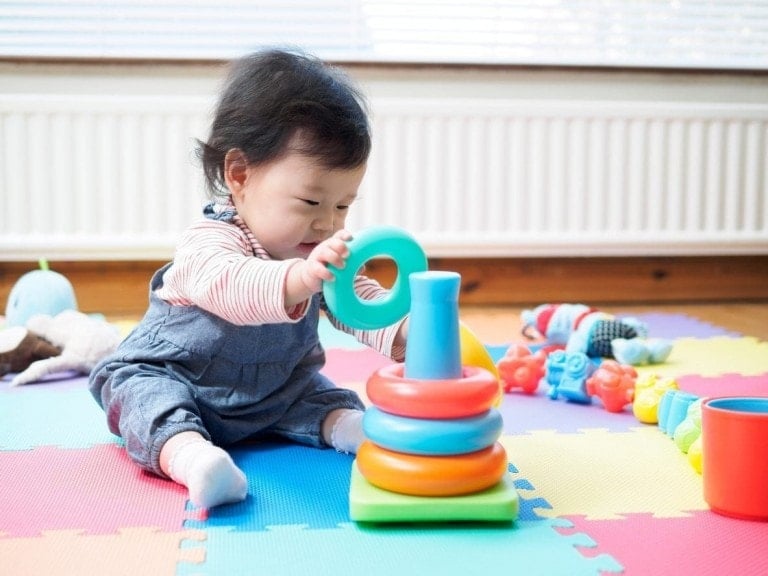Getting into a nap and bedtime routine with your baby is essential as a new parent, but figuring out how to lull them to sleep takes time. Every baby responds differently to soothing techniques. In the newborn stage, little ones are adjusting to life outside the womb, which is very different from the snug environment they knew for nine months. That’s why it helps to replicate that cozy space during the first few months and experiment to see what works best for your baby.
For many parents, these early moments are the ones we longed for before meeting our babies and the memories we’ll cherish as they grow. But what happens when your baby wants the snuggles to last all night? When they refuse to sleep unless pressed against your chest? Or when they cry the second you set them down in the crib or wake in the middle of the night, as soon as they realize you’re gone?
While all of this is normal (who wouldn’t rather sleep on a warm, snuggly mom than in a crib?), it isn’t always sustainable, especially during middle-of-the-night wakeups or busy daytime hours. That’s when many parents turn to Google for answers on how to teach their baby to self-soothe, a term often connected to gentle sleep training or coaching.
What Is Self-Soothing?
The term self-soothing regarding infants and sleep is taught to babies so they can put themselves to sleep initially and back to sleep during wake-ups. The concept of self-soothing promotes independence so that parents don’t need to respond to every wake-up during naps or in the middle of the night, and at the onset of sleep at night. Self-soothing would ideally eliminate the need for a parent or caregiver to go in and offer assistance. As you can imagine, there is a link with crying as a means to do this.
Interestingly, what we consider self-soothing for toddlers and adults is quite different. According to the Gottman Institute, self-soothing is an essential skill for everyone.1 But the steps they recommend to self-soothe require deep breaths, body awareness, meditation, and code words. These are all things an infant wouldn’t be capable of applying.
Teaching your baby to sleep independently sounds lovely, in theory. However, there are a few misconceptions about promoting self-soothing and when it is appropriate to focus on this skill.
When Can Babies Self-Soothe?
Quite possibly, the biggest misconception about self-soothing is that there is a specific age at which we can teach a baby this. Parents often hear that their child is ready to self-soothe and can retain this skill by four months. In actuality, there is no specific age at which babies can self-regulate. Instead, whether a baby can or can’t self-soothe depends on their temperament.
I often see even-tempered and mellow babies show signs of self-regulation reasonably early. These are the babies who will hang out in their crib, roll around, or play with their hair. They babble to themselves when they get older, seeming to have a grand old time. These babies may naturally start sleeping through the night or wake up and go back to sleep independently, with little teaching or training.
But many babies also show no signs of this well into later infancy, possibly not until 12 months or later. For these babies, self-soothing might seem near impossible. Most of the time, they aren’t developmentally ready to do this. According to one study that examined infant nighttime waking behaviors, researchers found that “younger infants tended to require parental intervention at night to return to sleep, whereas older infants exhibited a more significant proportion of self-soothing after nighttime awakenings. However, even in the 12-month-old group, 50% of infants typically required parental intervention to get back to sleep after waking.”2
Temperament and Developmental Readiness Matters
Temperament and developmental readiness are the key factors when parents decide whether to teach their baby to self-soothe. Parents can determine this by paying close attention to their child’s self-soothing behaviors. These behaviors include thumb sucking, moving their head from side to side, playing with their feet, using the pacifier, re-positioning, babbling, etc. Some infants may display these behaviors at 3.5 months. For others, it may be closer to 12 months. It is dependent on the individual child.
It is also important to note that infants typically do not engage in self-soothing behaviors when in distress but rather when calm.3 The good news is that even if a child shows zero signs of self-regulation, parents can do things to try to encourage this. Just understand that it is a gradual process.
Teaching Your Baby to Self-Soothe
If your baby is developmentally ready, these gentle strategies can help encourage self-soothing while still giving them the comfort they need.
1. Wait Until They’re Calm
While there is a link between self-soothing and crying, there is no substantial evidence that crying teaches infants how to soothe themselves. Because of this, many development experts (myself included) suggest that when helping a child learn to self-regulate, you do so when they are calm. You can do this during the nap or bedtime routine or awake windows by helping the child find their hand or finger to suck on, promoting the use of the pacifier, giving them a small lovey to play with (not sleep with), helping them find their hair and feet to play with, etc.
By encouraging these things, you show your baby that they have access to (safe) objects or body parts that can provide them with comfort. It is important to remember that doing this takes time. It is generally a long process that can take weeks or months, depending on the child. Sometimes, simply introducing hand sucking can help a child fall asleep independently. More often than not, it takes a lot of consistency and repetition.
2. Respond to Their Cries
Contrary to popular belief, responding to your baby when in distress (such as crying) will help promote self-soothing later. Many experts suggest that to help a child learn to self-soothe, you must give them your presence and affection, engage with them, and provide calm and empathy. So, while it might seem like you aren’t promoting independence by responding to your baby’s cries, most development experts believe the opposite to be true.
As a mom of seven, I can speak to this with firsthand experience. I attribute our children’s ability to fall asleep and stay asleep on their own partly to consistently responding to their cries using the “5 S’s soothing methods” and helping them regulate. But I also know that parents are exhausted and may not be able to wait until their child shows signs of self-soothing. If your baby is waking all night long, and you have to respond each time with no end in sight, there is hope for you!
3. Make Sure You Meet Other Needs
Often, when a child is waking frequently or struggling to get to sleep at the start of naps and bedtime, it is a sign that another area needs to be addressed. These areas include awake windows, sleep environment, routine, and nutrition.
For example, if you put your baby down past its natural sleep window, it will likely struggle to fall asleep. They’ll have an increase in cortisol and a decrease in melatonin, which causes them to become overstimulated. Similarly, if your child’s environment is not sleep-promoting, this can cause difficulty falling and staying asleep.
So, I recommend first addressing these things and then considering ways you can help your child sleep independently. Focus on self-soothing if your child is developmentally ready. If you are unsure where to start, focus on one thing you can do today to help improve your child’s sleep habits.
Your child’s ability to self-soothe will develop once your child is ready and with some assistance over time. There are small steps you can take now to encourage this later. In the meantime, know that it is okay to continue responding to your baby in various ways. If you feel lost and unsure how to do that, a sleep coach may be an excellent option as you navigate this process with your baby.
Final Thoughts
Every baby is unique, and self-soothing develops at their own pace. By responding with love, meeting their needs, and gently encouraging independence, you’ll help your baby build healthy sleep habits in time.





































